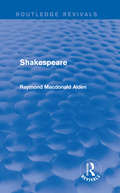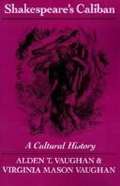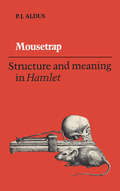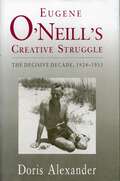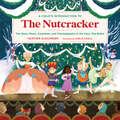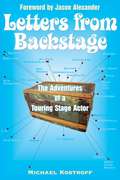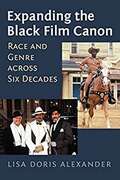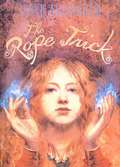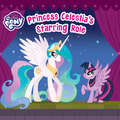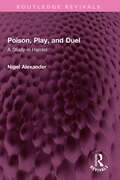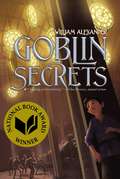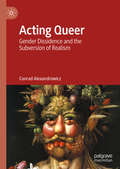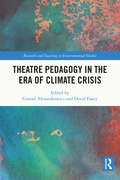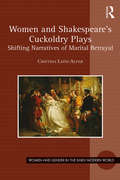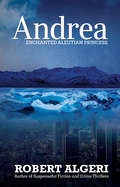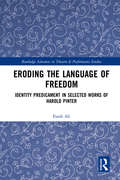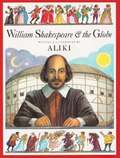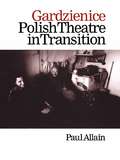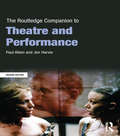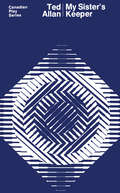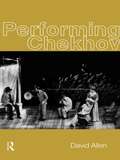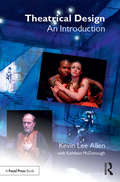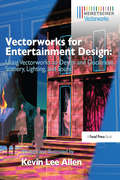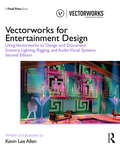- Table View
- List View
Shakespeare: From The Quarto Of 1609, With Variorum Readings And Commentary (Routledge Revivals)
by Raymond Macdonald AldenThis fascinating title, first published in 1922, presents a detailed overview of the life and works of Shakespeare. Alden first considers Shakespeare’s Elizabethan context, alongside exploring the Classical and Italian foundations, political theories, concepts and theatrical trends that influenced his works. Next, a comprehensive biography provides insight into Shakespeare’s probable education, relationships and contemporaries. The final sections are devoted to the genres into which Shakespeare’s works have been categorised, with full analyses of and backgrounds to the poems, histories, comedies and tragedies. An important study, this title will be of particular value to students in need of a comprehensive overview of Shakespeare’s life and works, as well as the more general inquisitive reader.
Shakespeare's Caliban: A Cultural History
by Alden T. Vaughan; Virginia Mason VaughanShakespeare's Caliban examines The Tempest's "savage and deformed slave" as a fascinating but ambiguous literary creation with a remarkably diverse history. The authors, one a historian and the other a Shakespearean, explore the cultural background of Caliban's creation in 1611 and his disparate metamorphoses to the present time.
Mousetrap: Structure and Meaning in Hamlet
by P. J. AldusThere is scarcely an element of Hamlet that has not received attention many times, yet both general reader and sophisticated critic would generally agree that the character of Hamlet and the full meanings of the play remain mysteries. No less a puzzle is the art of Hamlet, for, while the form of the art is elusive, the feeling of essential meaning is strong. Professor Aldus hopes to enlarge our understanding of Hamlet and our appreciation of Shakespeare as a conscious artist of great subtlety by studying the play's dramatic structure in the light of Aristotle's Poetics and its meaning as literary myth in the light of Plato's Phaedrus. This is a study of Hamlet as literary myth, a figurative mode of art in which structure is basic; yet primal myth, myth in the larger, non-literary sense, becomes part of it too, because the substance of Hamlet seems to be of this kind. Professor Aldus's reading of Hamlet is both radically new and decidedly provocative. A great deal of very careful inquiry has gone into the unearthing of connections which at first sight often seem improbable and tenuous, but which, one comes to find, have an illuminating total unity. Future commentators may not accept all that Professor Aldus has to say about, for example, Ophelia's crown of flowers, but they will hardly be able to ignore it.
Eugene O'Neill's Creative Struggle: The Decisive Decade, 1924–1933 (G - Reference, Information and Interdisciplinary Subjects)
by Doris AlexanderIn Eugene O'Neill's Creative Struggle, Doris Alexander gives us a new kind of inside biography that begins where the others leave off. It follows O'Neill through the door into his writing room to give a blow-by-blow account of how he fought out in his plays his great life battles—love against hate, doubt against belief, life against death—to an ever-expanding understanding. It presents a new kind of criticism, showing how O'Neill's most intimate struggles worked their way to resolution through the drama of his plays. Alexander reveals that he was engineering his own consciousness through his plays and solving his life problems—while the tone, imagery, and richness of the plays all came out of the nexus of memories summoned up by the urgency of the problems he faced in them. By the way of O'Neill, this study moves toward a theory of the impulse that sets off a writer's creativity, and a theory of how that impulse acts to shape a work, not only in a dramatist like O'Neill but also in the case of writers in other mediums, and even of painters and composers. The study begins with Desire Under the Elms because that play's plot was consolidated by a dream that opened up the transfixing grief that precipitated the play for O'Neill, and it ends with Days Without End when he had resolved his major emotional-philosophical struggle and created within himself the voice of his final great plays. Since the analysis brings to bear on the plays all of his conscious decisions, ideas, theories, as well as the life-and-death struggles motivating them, documenting even the final creative changes made during rehearsals, this book provides a definitive account of the nine plays analyzed in detail (Desire Under the Elms, Marco Millions, The Great God Brown, Lazarus Laughed, Strange Interlude, Dynamo, Mourning Becomes Electra, Ah, Wilderness!, and Days Without End, with additional analysis of plays written before and after.
Eugene O'Neill's Creative Struggle: The Decisive Decade, 1924–1933
by Doris AlexanderIn Eugene O'Neill's Creative Struggle, Doris Alexander gives us a new kind of inside biography that begins where the others leave off. It follows O'Neill through the door into his writing room to give a blow-by-blow account of how he fought out in his plays his great life battles—love against hate, doubt against belief, life against death—to an ever-expanding understanding. It presents a new kind of criticism, showing how O'Neill's most intimate struggles worked their way to resolution through the drama of his plays. Alexander reveals that he was engineering his own consciousness through his plays and solving his life problems—while the tone, imagery, and richness of the plays all came out of the nexus of memories summoned up by the urgency of the problems he faced in them. By the way of O'Neill, this study moves toward a theory of the impulse that sets off a writer's creativity, and a theory of how that impulse acts to shape a work, not only in a dramatist like O'Neill but also in the case of writers in other mediums, and even of painters and composers. The study begins with Desire Under the Elms because that play's plot was consolidated by a dream that opened up the transfixing grief that precipitated the play for O'Neill, and it ends with Days Without End when he had resolved his major emotional-philosophical struggle and created within himself the voice of his final great plays. Since the analysis brings to bear on the plays all of his conscious decisions, ideas, theories, as well as the life-and-death struggles motivating them, documenting even the final creative changes made during rehearsals, this book provides a definitive account of the nine plays analyzed in detail (Desire Under the Elms, Marco Millions, The Great God Brown, Lazarus Laughed, Strange Interlude, Dynamo, Mourning Becomes Electra, Ah, Wilderness!, and Days Without End, with additional analysis of plays written before and after.
A Child's Introduction to the Nutcracker: The Story, Music, Costumes, and Choreography of the Fairy Tale Ballet (A Child's Introduction Series)
by Heather AlexanderBallet enthusiasts of all ages will delight in the magical story of The Nutcracker and the magnificent ballet it inspired in this enchanted book packed with colorful illustrations, fun facts, history, music, and the love of dance. Whether The Nutcracker is your first ballet experience or you&’re already a master dancer, everything you love and want to know about this special, sugar-spun, snow-dusted ballet can be found in these delightful pages. Follow The Nutcracker as it makes its way from page to stage to become the world&’s most popular holiday ballet. Learn all about the dazzling steps, spins, and jumps choreographed by Petipa, Ivanov, and Balanchine, and meet the famed composer Tchaikovsky. Special sections highlight some of the most famous dancers and companies that have brought the performance and the magic of this ballet to life.Packed with charming illustrations showcasing the beautiful costumes and lavish sets, plus removable poster for you to color, A Child&’s Introduction to the Nutcracker lets you to enjoy this magical ballet all year round!
Letters from Backstage: The Adventures of a Touring Stage Actor
by Jason Alexander Michael KostroffEver wonder what it's like to be a real working actor? Wonder no more! Michael Kostroff is here to reveal, in hilarious detail, just what it's like to travel with the road companies of The Producers and Les Miserables. His firsthand account of the exciting, funny, and sometimes bizarre highlights of his journey includes working at a temp job when his agent calls to say, "You got the part!"; singing on a revolving stage while lugging a dead body; seeing ghosts in haunted theaters; and much more. Along the way, anecdotes about nailing an audition, keeping a performance fresh, and getting along with fellow cast members give useful tips for working actors. Anyone who wants to know what a life in the theater is really like needs this intimate and unforgettable narrative.
Expanding the Black Film Canon: Race and Genre Across Six Decades
by Lisa Doris AlexanderIf the sheer diversity of recent hits from Twelve Years a Slave and Moonlight to Get Out, Black Panther, and BlackkKlansman tells us anything, it might be that there’s no such thing as “black film” per se. This book is especially timely, then, in expanding our idea of what black films are and, going back to the 1960s, showing us new and interesting ways to understand them. <p><p> When critics and scholars write about films from the Blaxploitation movement—such as Cotton Comes to Harlem, Shaft, Superfly, and Cleopatra Jones—they emphasize their importance as films made for black audiences. Consequently, Lisa Doris Alexander points out, a film like the highly popular, Oscar-nominated Blazing Saddles—costarring and co-written by Richard Pryor—is generally left out of the discussion because it doesn’t fit the profile of what a black film of the period should be. This is the kind of categorical thinking that Alexander seeks to broaden, looking at films from the 60s to the present day in the context of their time. Applying insights from black feminist thought and critical race theory to one film per decade, she analyzes what each can tell us about the status of black people and race relations in the United States at the time of its release. <p><p> By teasing out the importance of certain films excluded from the black film canon, Alexander hopes to expand that canon to include films typically relegated to the category of popular entertainment—and to show how these offer more nuanced representations of black characters even as they confront, negate, or parody the controlling images that have defined black filmic characters for decades.
The Rope Trick
by Lloyd AlexanderIt's magic! The great American storyteller Lloyd Alexander conjures an engrossing tale of a bewitching magician. Lidi is not only beautiful, she has the talent to perform the greatest magic feat imaginable--the rope trick. But she must find the one master who can teach her how. On her quest to find master magician Ferramondo, she meets some traveling companions who all help on the journey: a child with true supernatural powers, a handsome outlaw with a price on his head, a successful entrepreneur who wants her in his troupe. But when the child is kidnapped, Lidi must abandon the search and summon her own powers to save the girl. The thrilling conclusion is Alexander at the top of his form in a remarkable fantasy that is both light and dark, funny and serious, believable and mystical. As always with an Alexander novel, the real magician is the storyteller himself.
Princess Celestia's Starring Role (My Little Pony)
by Louise AlexanderIt's the 1,111th anniversary of when Princess Celestia first raised the sun, and Twilight Sparkle knows just how to celebrate: with a play starring Princess Celestia herself! The only problem is Princess Celestia can't act! Can Twilight Sparkle find a way to break it to her mentor and save the show?This storybook is based on an episode of My Little Pony: Friendship is Magic, as seen on Discovery Family and Netflix.© 2019 Hasbro. All Rights Reserved.
Poison, Play, and Duel: A Study in Hamlet (Routledge Revivals)
by Nigel AlexanderFirst published in 1971, Poison, Play and Duel explores the dominant symbols of the language and action of Hamlet. The Ghost first reveals that Claudius murdered his brother by poison, and this act of poisoning is then dramatically presented before the King. The ultimate consequence of the ‘poison in jest’ performed by the actors is the poisoned ‘play’ with rapiers between Laertes and Hamlet. This representation of violence, and the vengeful response to violence, creates the moral and the psychological problems of Hamlet. Critics naturally question, and disagree about, the way that Hamlet plays his role in this play because the role of Hamlet is a theatrical device designed to bring all human actions into debate and question. It is hardly surprising that audiences have seen mirrored in Hamlet their own most fundamental and inescapable problems. Nigel Alexander shows how Shakespeare, like Raphael, Titian and other Renaissance artists, developed and adapted the imagery inherited from the Christian and classical past. The battle within the soul, the choice of life, the hunt of passion, the triple face of prudence and the dance of the graces are given dramatic habitation in Hamlet’s soliloquies, in the inner-play and in the savage contrast of sexuality between Gertrude and Ophelia. This book will be of interest to students of literature, drama, psychology and philosophy.
Goblin Secrets
by William AlexanderA boy joins a theatrical troupe of goblins to find his missing brother.In the town of Zombay, there is a witch named Graba who has clockwork chicken legs and moves her house around--much like the fairy tale figure of Baba Yaga. Graba takes in stray children, and Rownie is the youngest boy in her household. Rownie's only real relative is his older brother Rowan, who is an actor. But acting is outlawed in Zombay, and Rowan has disappeared.Desperate to find him, Rownie joins up with a troupe of goblins who skirt the law to put on plays. But their plays are not only for entertainment, and the masks they use are for more than make-believe. The goblins also want to find Rowan--because Rowan might be the only person who can save the town from being flooded by a mighty river.This accessible, atmospheric fantasy takes a gentle look at love, loss, and family while delivering a fast-paced adventure that is sure to satisfy.<P><P> Winner of the National Book Award
Acting Queer: Gender Dissidence and the Subversion of Realism
by Conrad AlexandrowiczThis book is situated at the intersection of queer/gender studies and theories of acting pedagogy and performance. It explores the social and cultural matrix in which matters of gender are negotiated, including that of post-secondary theatre and drama education. It identifies the predicament of gender dissident actors who must contend with the widespread enforcement of realist paradigms within the academy, and proposes a re-imagining of the way drama/theatre/performance are practised in order to serve more fairly and effectively the needs of queer actors in training. This is located within a larger project of critique in reference to the art form as a whole. The book stimulates discussion among practitioners and scholars on matters concerning various kinds of diversity: of gender expression, of approaches to the teaching of acting, and to the way the art form may be imagined and executed in the early years of the 21st Century, in particular in the face of the climate crisis. But it is also an aid to practitioners who are seeking new theoretical and practical approaches to dealing with gender diversity in acting pedagogy.
Theatre Pedagogy in the Era of Climate Crisis (Research and Teaching in Environmental Studies)
by Conrad Alexandrowicz David FancyThis volume explores whether theatre pedagogy can and should be transformed in response to the global climate crisis. Conrad Alexandrowicz and David Fancy present an innovative re-imagining of the ways in which the art of theatre, and the pedagogical apparatus that feeds and supports it, might contribute to global efforts in climate protest and action. Comprised of contributions from a broad range of scholars and practitioners, the volume explores whether an adherence to aesthetic values can be preserved when art is instrumentalized as protest and considers theatre as a tool to be employed by the School Strike for Climate movement. Considering perspectives from areas including performance, directing, production, design, theory and history, this book will prompt vital discussions which could transform curricular design and implementation in the light of the climate crisis. Theatre Pedagogy in the Era of Climate Crisis will be of great interest to students, scholars and practitioners of climate change and theatre and performance studies.
Women and Shakespeare's Cuckoldry Plays: Shifting Narratives of Marital Betrayal (Women and Gender in the Early Modern World)
by Cristina León AlfarHow does a woman become a whore? What are the discursive dynamics making a woman a whore? And, more importantly, what are the discursive mechanics of unmaking? In Women and Shakespeare’s Cuckoldry Plays: Shifting Narratives of Marital Betrayal, Cristina León Alfar pursues these questions to tease out familiar cultural stories about female sexuality that recur in the form of a slander narrative throughout William Shakespeare’s work. She argues that the plays stage a structure of accusation and defense that unravels the authority of husbands to make and unmake wives. While men’s accusations are built on a foundation of political, religious, legal, and domestic discourses about men’s superiority to, and rule over, women, whose weaker natures render them perpetually suspect, women’s bonds with other women animate defenses of virtue and obedience, fidelity and love, work loose the fabric of patrilineal power that undergirds masculine privileges in marriage, and signify a discursive shift that constitutes the site of agency within a system of oppression that ought to prohibit such agency. That women’s agency in the early modern period must be tied to the formations of power that officially demand their subjection need not undermine their acts. In what Alfar calls Shakespeare’s cuckoldry plays, women’s rhetoric of defense is both subject to the discourse of sexual honor and finds a ground on which to “shift it” as women take control of and replace sexual slander with their own narratives of marital betrayal.
Andrea: Enchanted Aleutian Pricess
by Robert AlgeriI met Andrea Altiery in 1981; the first thing she asked was, “Do you like the rock band Aerosmith?” I responded, “Yes.” She smiled and slapped me on my left shoulder telling me, “Dream on my friend.” Later that year Andrea was taken from us by the most notorious serial killer to ever hunt in the state of Alaska. Get ready to collectively ride an emotional ride through urban Alaska while looking through a steamy window for lost love; love that's never found and love that maybe never was. I can only imagine the helplessness; the complete feeling of being alone these women had; Andrea must have had, preyed upon all of their spirit's gathering together now. Victims of circumstance; none of these women deserved to be mistreated like Andrea; dehumanized, erased from our minds. One last chance to give Andrea a voice, each woman asking us can you hear me, do you see me now?
Eroding the Language of Freedom: Identity Predicament in Selected Works of Harold Pinter (Routledge Advances in Theatre & Performance Studies)
by Farah AliLet down by the uncertainties of memory, language, and their own family units, the characters in Harold Pinter’s plays endure persistent struggles to establish their own identities. Eroding the Language of Freedom re-examines how identity is shaped in these plays, arguing that the characters’ failure to function as active members of society speaks volumes to Pinter’s ideological preoccupation with society’s own inadequacies. Pinter described himself as addressing the state of the world through his plays, and in the linguistic games, emotional balancing acts, and recurring scenarios through which he put his characters, readers and audiences can see how he perceived that world.
William Shakespeare and the Globe
by AlikiFrom "Hamlet", to "Romeo and Juliet", to "A Midsummer Night's Dream", Shakespeare's celebrated works have touched people around the world. Aliki combines literature, history, biography, archaeology, and architecture in this richly detailed and meticulously researched introduction to Shakespeare's world-his life in Elizabethan times, the theater world, and the Globe, for which he wrote his plays. Then she brings history full circle to the present-day reconstruction of the Globe theater.
Gardzienice: Polish Theatre in Transition (Contemporary Theatre Studies #Vol. 22)
by Paul AllainIn 1977, the Gardzienice Theatre Association, an experimental theatre company was founded in a tiny Polish village. By 1992 The Observer was hailing "Brilliant Gardzienice...and orgy of joy, anguish, prayer and lamentation performed in candlelight with hurtling energy and at breakneck speed...Physically reckless, thrillingly well sung...On no account to be missed. " Today the Gardzienice Theatre Association is hailed as Poland's leading theatre group, training Royal Shakespeare Company actors and touring the world. Paul Allain describes and analyses their sung performances, strenuous physical and vocal training, and anthropological fieldwork amongst marginalized European minorities. This is one of the first detailed attempts to assess developments in Polish experimental theatres since 1989. The author questions whether those artists can maintain their vision in the face of Poland's economic difficulties and increased commercialization of the arts.
The Routledge Companion to Theatre and Performance (Routledge Companions)
by Paul Allain Jen HarvieWhat is theatre? What is performance? What connects them and how are they different? What events, people, practices and ideas have shaped theatre and performance in the twentieth and twenty-first century? The Routledge Companion to Theatre and Performance offers some answers to these big questions. It provides an analytical, informative and engaging introduction to important people, companies, events, concepts and practices that have defined the complementary fields of theatre and performance studies. This fully updated second edition contains three easy to use alphabetized sections including over 120 revised entries on topics and people ranging from performance artist Ron Athey, to directors Vsevold Meyerhold and Robert Wilson, megamusicals , postdramatic theatre and documentation. Each entry includes crucial historical and contextual information, extensive cross-referencing, detailed analysis and an annotated bibliography. The Routledge Companion to Theatre and Performance is a perfect reference guide for the keen student.
My Sister's Keeper
by Ted AllanIn a tight, dramatic, two-character, two-act play Ted Allan, one of Canada's best-known playwrights, challenges us to think again about love and guilt, about madness and normalcy. My Sister's Keeper was first produced at the 1976 Lennoxville Festival in Quebec. (an earlier version, entitled 'I've Seen You Cut Lemons,' had been directed by Sean Connery at the Fortune Theatre in London in 1970.) It is a play about sensitivity and about victims; about what we do to each other and particularly about what society does to women; about what makes us able to love and what prevents us from allowing ourselves to love. One day 'schizophrenic' Sarah arrives--to stay--at the London flat of her successful, 'normal' brother. The ensuing confrontations lead us, when we can catch our breath, to ask just who it is that is insane, and why?
Performing Chekhov
by David AllenFirst published in 1999. Routledge is an imprint of Taylor & Francis, an informa company.
Theatrical Design: An Introduction
by Kevin Lee AllenA theatrical designer must address two questions when designing a production: What is the play about and what is the play like? To find the metaphor within a play is to unlock inspired and unique design concepts. Theatrical Design: An Introduction is about how to find the design idea for a production and what to do with that idea once identified. This book emphasizes script analysis and interpretation specifically for designers: how to release meaning and design inspiration from lines and characterization in a script. It then explains the artistic elements and principles of design—the skills necessary to create the design visualized. Concepts are illustrated with examples from theatre, film, art, architecture, and fashion that explore professional and historic use of conceptualization and metaphor. Theatrical Design: An Introduction imparts the tools designers need to innovate off the page.
Vectorworks for Entertainment Design: Using Vectorworks to Design and Document Scenery, Lighting, and Sound
by Kevin Lee AllenThe first book in the industry tailored specifically for the entertainment professional, Vectorworks for Entertainment Design covers the ins and outs of Vectorworks software for lighting, scenic, and sound design. With a detailed look at the design process, from idea to development, to the documentation necessary for execution, Vectorworks for Entertainment Design will encourage you to create your own process and workflow through exercises that build on one another. The text stresses the process of developing an idea, visualizing it, and evolving it for presentation, documentation, or drafting. The author focuses on both the technical how-to and the art of design, giving you the tools you need to learn and then use the application professionally. Fully illustrated with step-by-step instructions, it contains inspirational work from Broadway, major regional companies, and non-theatrical, entertainment design.
Vectorworks for Entertainment Design: Using Vectorworks to Design and Document Scenery, Lighting, Rigging and Audio Visual Systems
by Kevin Lee AllenVectorworks for Entertainment Design is the first book in the industry tailored for the entertainment professional. This second edition has been extensively revised and updated, covering the most current details of the Vectorworks software for scenery, lighting, sound, and rigging. With a focused look at the production process from ideation to development to documentation required for proper execution, the book encourages readers to better create their own processes and workflows through exercises that build on one another. This new edition introduces Braceworks, SubDivision modeling, and scripting using the Marionette tool, and covers new tools such as Video Camera, Deform Tool, Camera Match, Schematic Views, and Object Styles. Fully illustrated with step-by-step instructions, this volume contains inspirational and aspirational work from Broadway, Concerts, Regional Theatre, Dance, and Experiential Entertainment. Exploring both the technical how-to and the art of design, this book provides Theatre and Lighting Designers with the tools to learn about the application and use it professionally. Vectorworks for Entertainment Design also includes access to downloadable resources such as exercise files and images to accompany projects discussed within the book.
